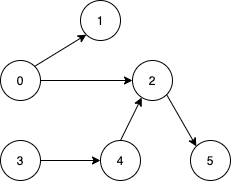Given a directed acyclic graph, with n vertices numbered from 0 to n-1, and an array edges where edges[i] = [fromi, toi] represents a directed edge from node fromi to node toi.
Find the smallest set of vertices from which all nodes in the graph are reachable. It's guaranteed that a unique solution exists.
Notice that you can return the vertices in any order.
Example 1:

Input: n = 6, edges = [[0,1],[0,2],[2,5],[3,4],[4,2]] Output: [0,3] Explanation: It's not possible to reach all the nodes from a single vertex. From 0 we can reach [0,1,2,5]. From 3 we can reach [3,4,2,5]. So we output [0,3].
Example 2:

Input: n = 5, edges = [[0,1],[2,1],[3,1],[1,4],[2,4]] Output: [0,2,3] Explanation: Notice that vertices 0, 3 and 2 are not reachable from any other node, so we must include them. Also any of these vertices can reach nodes 1 and 4.
Constraints:
2 <= n <= 10^51 <= edges.length <= min(10^5, n * (n - 1) / 2)edges[i].length == 20 <= fromi, toi < n- All pairs
(fromi, toi)are distinct.
老union find了,回顾一下,unionfind是一个算法/数据结构,用来查找某个节点的祖先,以及把两个节点关联(union)起来。最后把所有独立的祖先找出来
这题和547 friend cycle有点像
class Solution { public List<Integer> findSmallestSetOfVertices(int n, List<List<Integer>> edges) { Set<Integer> set = new HashSet(); boolean[] hasparent = new boolean[n]; int[] anc = new int[n]; for(int i = 0; i < n; i++) anc[i] = i; for(List<Integer> list : edges) { if(!hasparent[list.get(1)]) { union(list.get(1), list.get(0), anc); hasparent[list.get(1)] = true; } } for(int i = 0; i < n; i++) { set.add(find(anc, i)); } return new ArrayList(set); } public int find(int[] anc, int x) { if(x != anc[x]) anc[x] = find(anc, anc[x]); return anc[x]; } public void union(int x, int y, int[] anc) { int a = anc[x]; int b = anc[y]; anc[a] = b; } }
有点注意的是可能节点的parent不止一个,我们就先到先得吧,设置一个used数组。